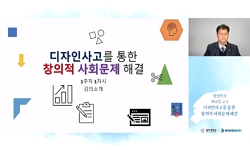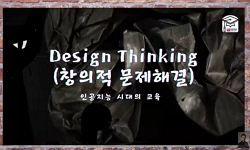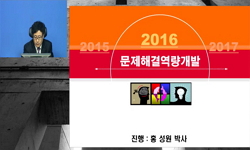Given our rapid societal change, the ability to solve problems using interdisciplinary knowledge and skills is becoming increasingly important. To support these educational needs, many international countries have adopted STEM/STEAM education as a cor...
http://chineseinput.net/에서 pinyin(병음)방식으로 중국어를 변환할 수 있습니다.
변환된 중국어를 복사하여 사용하시면 됩니다.
- 中文 을 입력하시려면 zhongwen을 입력하시고 space를누르시면됩니다.
- 北京 을 입력하시려면 beijing을 입력하시고 space를 누르시면 됩니다.

A comparison of the problem-solving strategies between high school engineering and science students in integrated STEM education
한글로보기https://www.riss.kr/link?id=A106070920
-
저자
성의석 (Purdue University)

- 발행기관
- 학술지명
- 권호사항
-
발행연도
2018
-
작성언어
English
-
주제어
design thinking ; problem-solving ; technology education ; STEAM ; think-aloud protocol ; 디자인 사고 ; 문제 해결 ; 기술 교육 ; STEAM ; 소리내어 말하기
-
등재정보
KCI등재
-
자료형태
학술저널
- 발행기관 URL
-
수록면
1-21(21쪽)
-
KCI 피인용횟수
0
- DOI식별코드
- 제공처
-
0
상세조회 -
0
다운로드
부가정보
다국어 초록 (Multilingual Abstract)
Given our rapid societal change, the ability to solve problems using interdisciplinary knowledge and skills is becoming increasingly important. To support these educational needs, many international countries have adopted STEM/STEAM education as a core learning platform. However, the fundamental differences of problem-solving strategies within the STEM/STEAM disciplines influence students’ cognitive structures and problem-solving strategies. To investigate the various problem-solving strategies used by science and engineering (technology) students, the researcher recruited six high school students, three from engineering courses and three from science courses. The participant students were taught a STEM/STEAM unit, but the engineering group had only participated in the physical modeling process. After completing the STEM/STEAM lessons, the two groups were given a design task with a structure similar to the integrated lessons. To assess the mental strategies of students, the researcher used the Concurrent-Think Aloud protocol and the seven of Halfin’s codes. The results showed that the engineering students tended to use a variety of problem-solving strategies, while the science students concentrated on solution-oriented strategies. The researcher also confirmed that the engineering students showed various design iterations by revisiting the problem identification process throughout the design process. However, the science students tended to show a limited number of iterations. The design outcomes also showed that the science students yielded many innovative design ideas but failed to provide details for their design solutions. When instructing STEM/STEAM lessons, educators need to utilize authentic instructional strategies to improve students’ integrative problem-solving abilities.
참고문헌 (Reference)
1 이춘식, "미국 STEM 교육의 최신 동향과 딜레마" 한국실과교육학회 25 (25): 101-122, 2012
2 이은상, "기술교과 정보통신기술 단원에서 STEAM 적용 수업이 중학생의 기술적 사고 성향에 미치는 효과" 한국기술교육학회 13 (13): 128-155, 2013
3 Korean Ministry of Education, Science and Technology, "The second basic plan to foster and support the human resources in science and technology (2011-2015)" MEST 2011
4 Duit, R., "The psychology of learning science" Routledge 65-85, 1991
5 DAVID P. CRISMOND, "The Informed Design Teaching and Learning Matrix" Wiley 101 (101): 738-797, 2012
6 Halfin, H. H., "Technology: A process approach" West Virginia University 1973
7 Leona Schauble, "Students' transition from an engineering model to a science model of experimentation" Wiley 28 (28): 859-882, 1991
8 International Technology and Engineering Educators Association (ITEA/ITEEA)., "Standards for technological literacy: Content for the study of technology" International Technology and Engineering Educators Association 2007
9 Corinne Kruger, "Solution driven versus problem driven design: strategies and outcomes" Elsevier BV 27 (27): 527-548, 2006
10 Sanders, M., "STEM, STEM education, STEMmania" 68 (68): 20-26, 2009
1 이춘식, "미국 STEM 교육의 최신 동향과 딜레마" 한국실과교육학회 25 (25): 101-122, 2012
2 이은상, "기술교과 정보통신기술 단원에서 STEAM 적용 수업이 중학생의 기술적 사고 성향에 미치는 효과" 한국기술교육학회 13 (13): 128-155, 2013
3 Korean Ministry of Education, Science and Technology, "The second basic plan to foster and support the human resources in science and technology (2011-2015)" MEST 2011
4 Duit, R., "The psychology of learning science" Routledge 65-85, 1991
5 DAVID P. CRISMOND, "The Informed Design Teaching and Learning Matrix" Wiley 101 (101): 738-797, 2012
6 Halfin, H. H., "Technology: A process approach" West Virginia University 1973
7 Leona Schauble, "Students' transition from an engineering model to a science model of experimentation" Wiley 28 (28): 859-882, 1991
8 International Technology and Engineering Educators Association (ITEA/ITEEA)., "Standards for technological literacy: Content for the study of technology" International Technology and Engineering Educators Association 2007
9 Corinne Kruger, "Solution driven versus problem driven design: strategies and outcomes" Elsevier BV 27 (27): 527-548, 2006
10 Sanders, M., "STEM, STEM education, STEMmania" 68 (68): 20-26, 2009
11 Ericsson, K. A., "Protocol analysis: Verbal reports as data" MIT Press 1993
12 NGSS Lead States, "Next generation science standards: For states" National Academies Press 2013
13 Patrick Foster, "Must we MST?" Virginia Tech Libraries 6 (6): 1994
14 Felder, R. M., "Learning and teaching styles in engineering education" 78 (78): 674-681, 1998
15 Indiana Department of Education, "Indiana Academic Standards for Science"
16 Todd Kelley, "Examining Elementary School Students’ Transfer of Learning Through Engineering Design Using Think-Aloud Protocol Analysis" Virginia Tech Libraries 28 (28): 2017
17 Bucciarelli, L. L., "Engineering philosophy" Dup Satellite 2003
18 Cross, N., "Engineering design methods: strategies for product design" The Open University 2008
19 권혁수, "Engineering Design: A Facilitator for Science, Technology, Engineering, and Mathematics [STEM] Education" 과학교육연구소 33 (33): 207-219, 2009
20 Cynthia J. Atman, "Engineering Design Processes: A Comparison of Students and Expert Practitioners" Wiley 96 (96): 359-379, 2007
21 Gall, M. D., "Educational research : An introduction" Pearson Education 2007
22 Horst W. J. Rittel, "Dilemmas in a general theory of planning" Springer Nature 4 (4): 155-169, 1973
23 Kees Dorst, "Creativity in the design process: co-evolution of problem–solution" Elsevier BV 22 (22): 425-437, 2001
24 Mosborg, S., "Conceptions of the engineering design process: An expert study of advanced practicing professionals" 2005
25 BRYAN R. LAWSON, "Cognitive Strategies in Architectural Design" Informa UK Limited 22 (22): 59-68, 1979
26 Professor D. B. Bromley, "Academic contributions to psychological counselling. 1. A philosophy of science for the study of individual cases" Informa UK Limited 3 (3): 299-307, 2007
동일학술지(권/호) 다른 논문
-
- 한국기술교육학회
- 최유현
- 2018
- KCI등재
-
2015 개정 중학교 ‘기술・가정’과 교육과정에서 생명기술시스템 관련 성취기준을 위한 ‘모의 전시회 체험 활동’ 수업 과정안 개발
- 한국기술교육학회
- 김성애
- 2018
- KCI등재
-
디자인 사고(Design Thinking)에 기반한 ‘유임승차’ 앱(App)의 설계
- 한국기술교육학회
- 김용익
- 2018
- KCI등재
-
- 한국기술교육학회
- 정진우
- 2018
- KCI등재
분석정보
인용정보 인용지수 설명보기
학술지 이력
| 연월일 | 이력구분 | 이력상세 | 등재구분 |
|---|---|---|---|
| 2026 | 평가예정 | 재인증평가 신청대상 (재인증) | |
| 2020-01-01 | 평가 | 등재학술지 유지 (재인증) |  |
| 2017-01-01 | 평가 | 등재학술지 유지 (계속평가) |  |
| 2014-01-08 | 학술지명변경 | 외국어명 : 미등록 -> THE KOREAN JOURNAL OF TECHNOLOGY EDUCATION |  |
| 2013-01-01 | 평가 | 등재학술지 유지 (등재유지) |  |
| 2010-01-01 | 평가 | 등재학술지 유지 (등재유지) |  |
| 2007-01-01 | 평가 | 등재학술지 선정 (등재후보2차) |  |
| 2006-01-01 | 평가 | 등재후보 1차 PASS (등재후보1차) |  |
| 2004-01-01 | 평가 | 등재후보학술지 선정 (신규평가) |  |
학술지 인용정보
| 기준연도 | WOS-KCI 통합IF(2년) | KCIF(2년) | KCIF(3년) |
|---|---|---|---|
| 2016 | 1.52 | 1.52 | 1.72 |
| KCIF(4년) | KCIF(5년) | 중심성지수(3년) | 즉시성지수 |
| 1.66 | 1.72 | 2.247 | 0.44 |




 KCI
KCI






